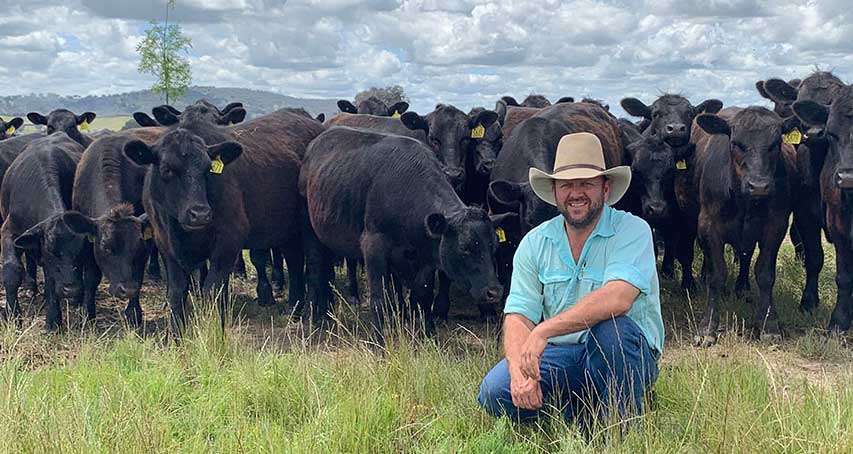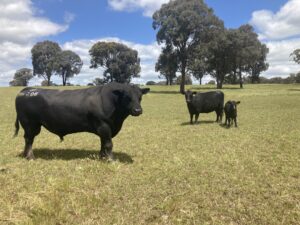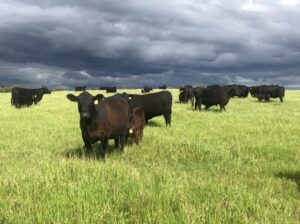Skinner sees much potential in Angus


Dane Skinner has continued a proud family tradition of breeding Angus since he bought Lawn Hill at Big Springs, south of Wagga Wagga, NSW, with his wife Alison.
The Skinners purchased Lawn Hill eight years ago, and added two further bordering properties to their holding five years ago. In all they run their cattle across 664ha of slightly undulating arable land featuring improved pastures, which they’re in the midst of adding to by sowing rye grass annually to create better quality feed.
 Mr Skinner succinctly described the climatic conditions of 2022 as “too wet”.
Mr Skinner succinctly described the climatic conditions of 2022 as “too wet”.
“In terms of growth we were a month behind 2021,” he said. “We started to get growth in spring and the cattle are going well, but the ground was too damp to pasture spray or top-dress too much.”
Growing up on Gunbar on the edge of the Hay Plains in the western Riverina region, Mr Skinner has been around Angus his entire life with his father and grandfather having both centred their breeding programs around the breed. It was a natural progression for him to continue with the breed when they bought Lawn Hill.
“The Angus handles most conditions well, and they’re well suited to our area. There are also plenty of good opportunities available with the breed market-wise.”
The Skinners have been carrying out AI programs in their herd for seven years, and to speed up their genetics gains they’ve started utilising the Zoetis Angus HeiferSELECT tool.
“We got to a point through our AI program where our oldest cows were five years old, so we were no longer culling for age,” he said.
“This led us to incorporating HeiferSELECT to gain further data on genetic potential. This tool has really allowed us to fine tune the herd. The first lot of heifers we marked as calves with HeiferSELECT were like peas in a pod in the paddock. The tool allows us to better select animals for genetic potential, and provides us with more figures to work from.
“I love data. Even though we’re commercial producers we tag at birth and record the dam and sire lineage of each calf just for our own information. We can also use this information to choose the females we carry forward, with kill data from the feedlots also informing this decision making process.”
The Skinners run fixed joinings in spring and autumn, with two-thirds of the females joined in spring and the remainder in autumn.
 “We join in spring from October 12. This normally involves one or two rounds of AI then the bulls go in for one cycle. Only the bulls are joined in autumn, purely to get as much value out of the herd as we can. We try to keep both joining periods at six weeks to tighten up our calving patterns. We’re achieving a fertility rate in the mid-90 per cent range across the herd.”
“We join in spring from October 12. This normally involves one or two rounds of AI then the bulls go in for one cycle. Only the bulls are joined in autumn, purely to get as much value out of the herd as we can. We try to keep both joining periods at six weeks to tighten up our calving patterns. We’re achieving a fertility rate in the mid-90 per cent range across the herd.”
Mr Skinner said they target the high-end, long-fed feedlot programs with the steer progeny produced.
“Rangers Valley and Kerwee feedlots have bought the majority of our stock. Our bull buying decisions are based around obtaining a high carcase, high marbling article, which is what they chase. Prices have been holding firm. We sold some via AuctionsPlus recently and received above average money.”
“We generally have tight parameters in relation to bull figures, we like intramuscular fat to be over four, eye muscle area needs to be up there, as well as 400-day growth and calving ease/days to calving.
Mr Skinner said they’ll continue to focus on genomics data correlation.
“We’ll look at where we go next with that in four or five years. We’ll also keep focussing on meat quality and the quality of our females. We place heavy emphasis on fertility to ensure we breed the best females we can so our steers and excess females sell well.”
Matt Sherrington, Queensland Country Life